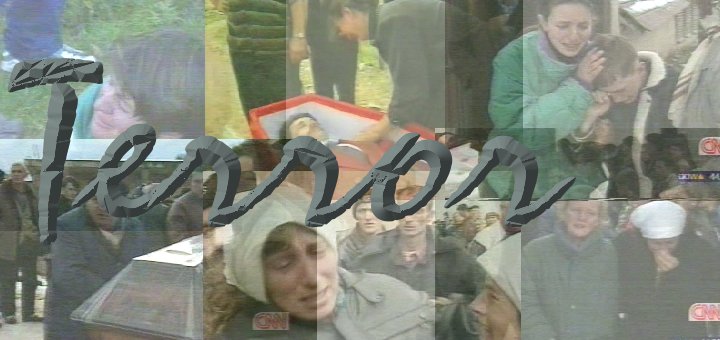
 |
In the spring of 1998 there were protest marches. Nine years earlier Milosevic had closed down their parliament and replaced it with something approaching a police state. They were no longer willing to accept having no voice in their own public affairs. So they marched.
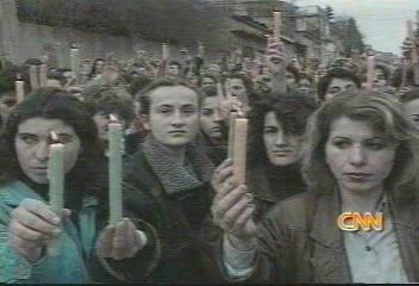 |
|
Click Image to Play Video [0:47]
|
They marched through the streets. They paraded to rallies. They marched quietly. They marched with candles. They marched with determination. [play video]
But marching was not acceptable to the police. They turned water cannons on the marchers. They chased them through the streets and parks. They beat them. They cordoned off streets with guns and tanks.
"Kosovo Albanian political leaders continue to urge restraint but patience is wearing thin and many peaceful protestors are now openly talking about the possibility of using weapons. 'Guns are not the answer' he says 'but at this point we have no other solution. There's no dialogue so how are we supposed to liberate ourselves?'" [WorldView, 4/29/98, quoting a protestor]
So they stopped marching and started shooting. The Kosovo Liberation Army grew from a handful to thousands. And that was when the terror began -- in earnest.
WorldView was telling the story of terror in the Balkans. They told it as stories about threat, stories about escaping from the threat, and stories about mourning when escape failed.
Threat
Yugoslavia against the Kosovo Liberation Army.
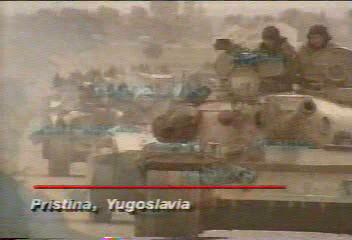 |
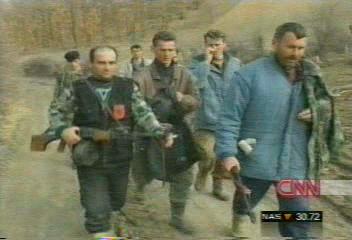 |
The KLA was a terrorist organization. When you are fighting terrorists it is war and there are no limits on what you can do.
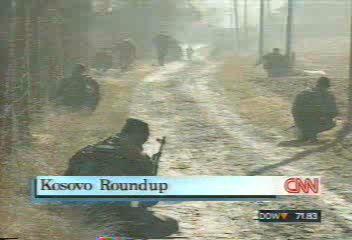 |
|
Click Image to Play Video [0:47]
|
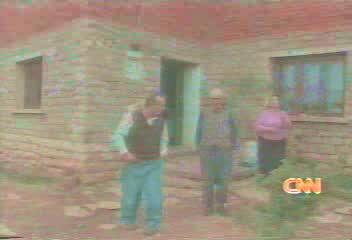 |
|
Click Image to Play Video [0:11]
|
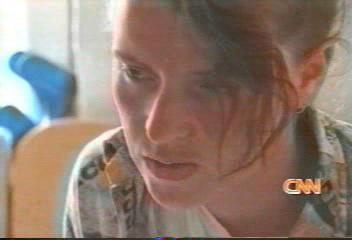 |
|
Click Image to Play Video [0:15]
|
Terrorists hide everywhere. You cannot tell a terrorist from a non-terrorist. Hence, every male is a candidate. There is no limit on who you can round up for interrogation. [play video]
The Yugoslav police went door to door searching for weapons and searching for men. It was the moment they had dreaded. He was taken away by the police. Don't be afraid he shouted to his family. But many men did not come back.
It is the threat that does not go away because there are no limits on what they can do. At any moment the police may show up and take you away -- never to return.
There are no limits on what the police may destroy. [play video] Any house, any structure is a potential hiding place for KLA fighters. One day, any day they can destroy. "They just showed up one day and shelled our house," he said.
For everyone whose house had not been destroyed this was the threat. If they did it there, if they did it then, they can do it here. The threat is ever present -- until you have been destroyed.
There are no limits on who they can shoot. If anyone may be a KLA terrorist then anyone can be shot as soon as they do something the least bit suspicious. [play video]
Trying to escape from the police is definitely suspicious. So she was shot.
The theat is not so much what they have done to you as it is what they may do to you. It is what you dread that may happen. Terror is living with what may happen.
Escape
 |
|
Click Image to Play Video [0:45]
|
Boom, boom, boom! The tanks came in with guns blazing. They destroyed houses wherever they pointed their guns. [play video]
The people fled. They fled the threat to their lives. They had to get away.
There is no convenient away, however. They fled to the hills. They put up temporary shelters; shelters that would not work in Kosovo winter. They had no food, no clothes, no housing, no water. But they had their lives.
Terror is living under the threat even if you have escaped it for the moment -- a moment that cannot last.
Mourning
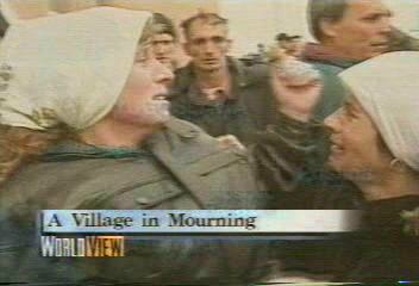 |
|
Click Image to Play Video [2:31]
|
When escape failed they mourned. [play video]
WorldView tells the story more eloquently than can we.
The stories of atrocity, the stories of mourning were more than anyone could tell.
Tangled talk about terror
The war on terror did not begin in September of 2001. It was already in full swing in 1998, and the Serbs wanted to join the army. They had terrorists, and they wanted to make war.
From January 5, 1998 through June 28, 1999 Serbs regularly characterized Kosovars as terrorists. They were just joining the war on terrorism, and they could not understand why they were not welcomed by the rest of the world. WorldView reports Milosevic saying, "If they [NATO] attack us we shall fight, but I don't know why because we didn't attack any NATO country. We are just fighting against terrorists that's all." [WorldView, March 18, 1999]
Words with a root of 'terror' occur 38 times in the news reports [Passages]. They are terror [5], terrorists [24], terrorism [4], and terrorize [5]. Thirty-one times the KLA or ethnic Albanians are said to be the terrorists or are said to engage in terrorist acts. The Serb police are never characterized as terrorists. However, Kosovars are said to be terrorized three times or to live in terror four times.
What has happened is a disconnection of 'terrorist' and 'terror' in the language of public affairs. The Kosovars are the people characterized as terrorized. If you extend the analysis to include 'afraid' and 'fear,' Kosovars again have a near monopoly -- 40 times in the news reports -- on being characterized as afraid or living in fear. It is they who are liable to be carried away by the police, whose houses are destroyed, who escape to living in tents in forests where they cannot be found. They are the ones who mourn in great number. Terrorized, afraid, living in fear would appear to be appropriate characterizations. However, the people who inflict the terror and the fear are not characterized as terrorists.
Instead the KLA is uniformly characterized as terrorists, engaged in terrorist activity, and engaged in terrorism. This is almost always the characterization of Serbs. Very early a reporter notes that the KLA is on the U.S. list of terrorist organizations. And another time a reporter asks a rhetorical question about the U.S. supporting a terrorist group. Otherwise the reporters attribute the characterization to Serbs.
Terrorists may impose terror on no one, on a few, or on many. Few or many may be terrorized by groups or instutions that are not terrorists. As the struggle over terrorism takes center stage the claims and counter claims about who is or is not a terrorist get further and further disconnected from terror.
Stories About Terror
Living in terror is definitely a humanitarian disaster. It was a humanitarian disaster that NATO could not permit to continue in Kosovo.
WorldView told the story of terror as threat, escaping the threat, and mourning when the escape failed. Terror, terrorists, afraid, living in fear was the language used in telling these stories.
WorldView was telling the story of terror in the Balkans: 1) because they could. Global communication made it possible to move video and live reports from anywhere to anywhere. CNN pioneered that capability. 2) because the audience to which they aspired would want to know. NATO was there, Russia was there, the U.N. was there -- these were the forces that became engaged in the Balkan conflict. When you aspire to a global audience that is what they want to know. 3) and they were there because they were great pictures.
 |
|
Escaping the Threat
|